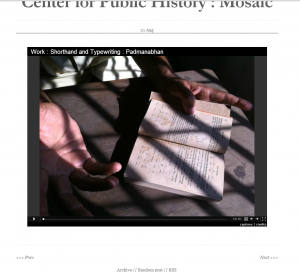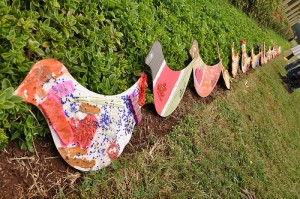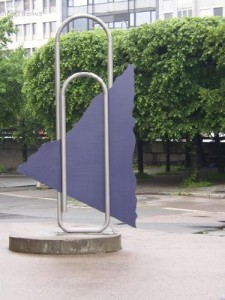-
Audacity and Audio – in Play and in Practice
3A session on working and playing with audio files using Audacity, which has a fairly low barrier to entry for editing sound objects. Depending on interest and ability, we can take either a practical or a playful approach. I’m happy to walk people through some of its basic functions useful to DHers working with sound- how to slice out clips properly, deal with proprietary formats, repair audio clips, overlay tracks, etc. Or we can play around with some of audacity’s fun effects – phase shifting, echoes, pitch alterations, reversing sound waves – useful to more creative endeavors and creating sound art. I’m especially interested in how tinkering with sound artifacts might offer us new ways to interpret them. When does a sound object become something else-something new? We can work with any sound files that people may bring in, though I’ll bring in some samples to play with. The prize goes to the person who can process an otherwise human voice into the scariest thing we’ve ever heard. -
23Oct
Categories
Connecting the personal story to public history for academia and journalism
I have been interested in connecting an individual, personal story to a public sense of histories of places, events, timelines. That is, I think there is a potential paradigm for threading stories, histories, archives and communities.
There is nothing new about this thought. Fields like oral histories/public history have well established research around these themes. But I want to put this proposal out there as a part-talk, part-make, part-teach session. I have very, very tiny seeds of the project that I can share, and it will be good to brainstorm around it, or see if there are folks interested in collaborating, too.
I am very much an outsider to digital humanities but I am hoping to learn and share (I am a research engineer who works with x-ray optics, and a journalist/amateur oral historian). I had been collecting oral histories at a physics research lab for half of 2009. Felt like it told a rich layered history of state-individual collaborations in science. That, then, broadened to interest in the intersection of scientific research and people’s histories….which then broadened to oral histories in other fields of work. The seeds I can talk about or illustrate are histories from two physicists who discuss the origin of a set of champagne bottles in a particle accelerator control room, and some other stories on dying traditions (woodwork for making musical instruments in India, shorthand and typing instruction schools). That is to say, each story is an independent experiment and is not connected to the other at all. But each offers a seed or point of departure.
All this finally led to some more plotting on oral history concepts. Here’s the premise (naivety and ignorance on my part will also become evident!):
— Each storyteller has many different stories.
— Each story has many different storytellers.
— Each story has many different theme and vice-versa, and so on…
— There must be a way to connect a personal history with public events and places.
— Each personal history can be connected to another using some categories/keywords/whatever-else: person, place (geography), timeline (when, year), event (is the story referring to an event like say, the SF earthquake of 1989 that someone else may also talk about in a seemingly unconnected way?).
— A story may have weak or strong associations to a set of attributes. This association can be weighted.
— There is an incredible range of stories recorded in university archives and other stand-alone oral history projects. The point is not to re-store them in a new space on the web. But there must be a way to re-point to them in a new scheme. That is, make the connections explicit.
— There is an incredible range of stories among all of us that feel like they are so irrelevant and unimportant to a wider audience. Can we make them relevant?
— Have multiple ways to add stories: upload, relink to existing, give contact for a volunteer to reach out, call in (toll free number), visit a recording center.
— Map out origin of each story. A map with dots shows where a particular thread has received stories from, providing an incentive to fill geographical gaps.
— Each story gets multiple keywords attached to it, reflecting the themes that the story touches on, besides the main subject matter thread.
— Cross links: The keywords are a point of entry into the many storytellers-many stories paradigm.What’s the point?
Let’s say something like this exists. Call it DH-Mosaic. Let’s say there’s a sociologist out there who is researching the history of wine making in the San Francisco Bay Area from 1850 to 2000. She has access to the usual set of archives at universities, and the state/national archives. She has access to archives of newspapers, books, papers, and such. And she does field work that gets her access to families in the industry. And she has access to DH-Mosaic, and she logs on and searches this clearinghouse/repository. Meanwhile, a few years ago, someone who was researching the history of high energy physics in the San Francisco bay area put out a book, and he had raw unused data. One of those pieces was an interview of a technician at a high energy physics lab in the region who mentioned that his family used to be in the wine making industry in the early 1980s and he left it in search of better opportunities. The high energy physics research didn’t have the space for this story. But the raw data is on (or linked on) DH-Mosaic, logged with metadata that points to: high energy physics, 1980, wine history, <name>, janitorial, magnets research, San Francisco bay area, Menlo Park. Our wine history researcher comes across this, and gets in touch with the author/owner of the story. In the course of talking to a new source, she finds out more first-hand sources about say, a labor struggle in the wine making industry in the 1980s, which takes her research in a slightly different direction….Similarly a reporter investigating the domino effect of the Vietnam War protests in 1970 in California may find a story and follow up with <name> after listening to his story of clearing up broken glass following the 1970 Stanford student protesters.What are some questions?
— How to make these links?!
— If you have a story, how do you define its relevance to a place/event/timeline/person/theme?
— Who defines the relevance?
— Within a specific story, how do you weight different aspects discussed?
— Who defines this relevance?
— How can this be done easily for a user interface?
— Is it possible to get users and researchers to shape the categorization?
— How do we get raw unused data (before it becomes a produced story/research paper) that just piles up for every researcher/reporter become a relevant trail of history?
— There is the larger issue of copyright, censorship, spam and what-not. But I am not even going there yet :)!Why?
Loved this little quote from Michael Ondaatje’s book, Divisadero: “For we live with those retrievals from childhood that coalesce and echo throughout our lives, the way shattered pieces of glass in a kaleidoscope reappear in new forms and are song-like in their refrains and rhymes, making up a single monologue. We live permanently in the recurrence of our own stories, whatever story we tell. ”
-
data mining bodies in motion
Although there are projects considering parsing pedestrian movement (e.g. sitting, walking, waving), there is a great deal of abstract movement going on in the world. The DOD would really like to be able to mine 2D film for patterns to prevent and or locate actions…but I want to look at possible tools for mining 3D and 2D data. For instance, how can GIS help map stage settings and flow? might seem to be an off-the-wall idea, but those of us studying movement in and out of performing arts, are desirous of the ability to mine our texts…non-verbal texts. well, it’s a thought!
-
Kids Track takes flight
Kids Tracks!
With 24 kids attending THATCampVA 2013, (wow!) we thought a few notes would help a smooth Camp for parents and kids.
We will offer 2 tracks, one geared towards older kids, the other geared towards younger. The tracks, much like the rest of THATCamp, are not strict; siblings, friends, and interested kids can choose whichever track suits best.
With such a strong showing from the under 20 set, we will need your creativity and participation. Consider taking a break from the adult track and deconstructing an old phone with some kids or participating in the kids aerial photography session. We are seeking 2-3 adults per kids session.
As a adult volunteer, what are you signing up for? A bit of fun and hacking:
- Minecraft, Printcraft, and game making
- GIS Scavenger Hunt
- MaKey MaKey Kit, Drawdio, Arduinio Hacking for Kids
- 3D Printer
- Deconstruction Table (P.S. We are seeking old phones, no longer working mechanical things-clocks, computers, etc. for kids to take apart.)
- Aerial Photography
- Outdoor Play
- Kid Friendly Programming (alice.org)
- Monticello-focuses session
- Art Station
- Board Games
- Have a good idea for a kid-focused session? Let us know!
9:30 Saturday marks the Adult Planning session and a concurrent “getting to know you” kids session; 10:45 am we will schedule the pre-planned blocks for kids sessions.
Parents, please note lunch will be provided, but afternoon snacks will be limited.
Tags: kids track
-
Bots
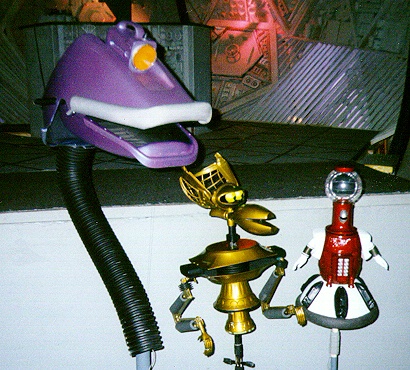
Err, not those though. What I’d love to talk about is Twitter bots, and if someone’s willing to help out, to maybe hack away at one.
Which is to say: I’d be thrilled to sit and swap favorite bots, and talk over their concepts and uses—diversion, cultural remix, pedagogical tool, pseudorandom art project (hi @horse_ebooks), anything. But I’d also be thrilled to learn from those who have actually implemented the things how to get started on making one, and possibly make one collectively during the session. (For instance, and to my great surprise, there doesn’t yet seem to be a THATCampBot.)
My thoughts here are inspired by Mark Sample’s proposal for THATCamp Leadership (leadership2013.thatcamp.org/2013/10/08/build-a-bot/) as well as bots of his like @DependsUponBot, @JustToSayBot, and others like Zach Whalen’s @pelafina_lievre, and others beside. But anything we talk through or make doesn’t have to be complicated: some don’t even require hacking, just text, as Tully Hansen explains.
But anyway: bots. I’m informed, by highly-placed and unimpeachable sources, that UVA’s Scholars Lab is “plagued” with them—let’s set to work spreading that plague.
(photo credit: Crow T. Robot, This Is Your Life)
-
09Oct

Categories
“Mapping Segregation: Racial patterns of residence, land ownership, and rentals in Rivanna Dist., Albemarle County”
My current research project is aimed at locating the residence of 6500+ inhabitants listed in the 1940 census of Albemarle County. This work will be presented at the Virginia Forum in March 2014 and I am hoping that discussions of mapping techniques and relevant historical issues at ThatCamp can guide me in completing a project that will have technical and historical merit.
There will be a dot on the map for each person that will display their 1940 census record when clicked. I plan to group residents into four classes: white land owners, black land owners, white renters, and black renters. I want to represent this information with semi-transparent spatial density layers created from the dots for each grouping, which ought to allow the viewer to intuitively perceive the spatial relationship between each group and a base layer of land ownership by race.
The geodatabase will contain all significant census data for each individual. This will allow map users to explore the relationships betwe
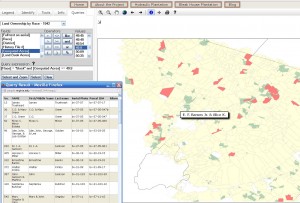 en categories of census data and land ownership by way of Boolean queries. For example, it might be interesting to look at the relationship between race, level of education, and acres owned. The query results can be exported to a spreadsheet for analysis and will be displayed as selections on the map (see map image and use Firefox to view interactive map at people.virginia.edu/~rwv6ad/CVHR/map1/ ). At this stage the goal of this project is not to answer questions about racial segregation in a rural setting, but to provide data and tools to begin to formulate interesting and relevant questions that may emerge from viewing data in a spatial context.
en categories of census data and land ownership by way of Boolean queries. For example, it might be interesting to look at the relationship between race, level of education, and acres owned. The query results can be exported to a spreadsheet for analysis and will be displayed as selections on the map (see map image and use Firefox to view interactive map at people.virginia.edu/~rwv6ad/CVHR/map1/ ). At this stage the goal of this project is not to answer questions about racial segregation in a rural setting, but to provide data and tools to begin to formulate interesting and relevant questions that may emerge from viewing data in a spatial context.From a broader historical perspective, I have been interested in the formation of rural African-American communities after the Civil War from the enslaved communities that existed on farms and plantations. How did freedmen acquire land and what was the quality of the land they purchased? When, how and where were black churches and schools established? These are the institutions that formalized the identities of rural African-American communities. When and how were the names of these communities incorporated into land and tax records? — in essence, recognized as distinct entities by white county administrators.
My guiding concept in this research is that segregation implies not only social, but physical separation. Therefore, it seems that spatial mappings of race and residence must be a foundational tool for studying themes like the one proposed for the upcoming Virginia Forum, “the creation, maintenance, or transgression of racial boundaries.”
Tags: GIS, interactive maps, land ownership, race, segregation
-
Hotels
I just updated the Location and Logistics page to include information about blocks of rooms for two hotels in the area:
Cavalier Inn
Rate: $87/night
Reservations: call 434-296-8111 or 1-888-882-2129
Cut-Off Date: Oct. 9th
Block Name: THATCampVA 2013Red Roof Inn
Rate: $79.99/night
Reservations: call 800-redroof or 434-295-4333
Cut-Off Date: Oct 7th
Block name: UVA ALDERMAN LIB THATCAMPVA 2013 groupIf you need a hotel for the weekend, be sure to book early! We’re working on reserving blocks of rooms at other hotels, and we’ll update the site as soon as that happens.
-
Kid-Friendly THATCamp!
Creativity is the pulse of the digital humanities. The ‘hmmm, what will we build today?’ ethos,so well nurtured by THATCamps, may arise out of new collaborations, new questions – or new approaches to existing questions, or it is simply the delightful outcome of not quite releasing our inner children. Children, as Sir Ken Robinson reports, ask why can’t a paperclip be 200 FT tall and made of foam rubber, (or at least prototyped at 1/800th scale with a 3D printer).
Do you, umm, your kids, want to tinker in the sandbox? Lined up so far – and as always, open to your input and suggestions – activities for the 5+ crowd:
- Electronics disassembly workbench
- Computer and board games (Minecraft meets 4-Square)
- Create your own board game materials
- Play-doh
- 3D print Minecraft creations
- Soft Circuit maker materials
- GPS Scavenger Hunt
As last year, kids are welcome to accompany parents to Friday workshops and attend all day Saturday. Pack your inner-child and all the kids and head to the kid-friendly THATCampVA 2013! Register here.
Tags: kids track
-
Registration for THATCampVA 2013 is now open!
We’re excited to say that registration is now open for approximately 80 participants at THATCampVA! Slots will be filled on a first-come, first-served basis, so register early.
Register now!
CLOSING DATE: September 30
What’s this now?
You know! A regional THATCamp.When?
THATCampVA will be held on Friday and Saturday, November 8-9, 2013. We have plans for workshops starting Friday afternoon, but if you send us your fabulous workshop idea, we may be able to offer a workshop track on Saturday as well. On Saturday the THATCampVA unconference itself, with a track designed especially for kids and adult track sessions generated by the participants, will be held from 9:00 a.m. to 5:00 p.m. Opportunities for social time with friends old and new will be available on Friday night, November 8, at nearby establishments.
Where?
Charlottesville, Virginia (at UVA Library’s Scholars’ Lab)Who?
Organizers include digital humanities folks from UVA, Mary Washington, and Virginia Tech— but this is your unconference!Anybody with energy and an interest in the humanities and/or technology should attend: graduate students, scholars, librarians, archivists, museum professionals, developers and programmers, administrators, managers, and funders; people from the non-profit sector, the for-profit sector, and interested amateurs. We say any- and everybody, and especially those who would find this interesting but who may never have been to a THATCamp or anything like it before.
Questions in the meantime? Email us!
Watch this space for more news soon — and follow us at @THATCampVA.
-
Camp Dates, Workshops, Kids Track
We’ve updated the dates for the VA 2013 camp: November 8–9. We’ll have a slate of hotels reserved for attendees, and will post that information soon. The unconference will be the second day, November 9. We’re planning to offer workshops as well, and depending on the number of and interest in those, we may offer them both days. We’ve already got a few workshop ideas in the works:
- Introduction to Git & Github – Eric Rochester
- Teaching Digital Humanities – Jeff McClurken
- 3D Modeling and Printing – Wayne Graham and Jeremy Boggs
- DIY Aerial Photography – Chris Gist
- Data Management for Digital Humanities – Purdom Lindblad and Andi Ogier
If you like these ideas, or if there’s a workshop you’d like to see us organize, please leave a comment! And if you have a workshop you’d like to offer, let us know that too!
We’re also planning to have a track specifically for kids. A few ideas we have for that include:
- Sandbox room/game play room? (minecraft/scratch loaded computers)
- 3D print Minecraft creations e.g. www.printcraft.org/
- Kodoble and Hopscotch are free iPad games aimed at teaching young kids to code
- “Soft circuit” maker materials?
- Board game session. (Something like Forbidden Island or Settlers of Catan? Or have kids create their own board games?)
- GPS Scavenger Hunt
We’d love to hear from folks planning to attend in November. What workshops would you like to attend or do you think would be interesting, for kids’ or adults? Interested in helping out with the kids’ track? Please share in the comments! We’ll formalize the slate of workshops and events for both tracks in September, so you’ve got plenty of time to contribute.
Tags: kids track, logistics, workshops

